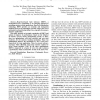Free Online Productivity Tools
i2Speak
i2Symbol
i2OCR
iTex2Img
iWeb2Print
iWeb2Shot
i2Type
iPdf2Split
iPdf2Merge
i2Bopomofo
i2Arabic
i2Style
i2Image
i2PDF
iLatex2Rtf
Sci2ools
IPPS
2010
IEEE
2010
IEEE
Improving the performance of hypervisor-based fault tolerance
Hypervisor-based fault tolerance (HBFT), a checkpoint-recovery mechanism, is an emerging approach to sustaining mission-critical applications. Based on virtualization technology, HBFT provides an economic and transparent solution. However, the advantages currently come at the cost of substantial overhead during failure-free, especially for memory intensive applications. This paper presents an in-depth examination of HBFT and options to improve its performance. Based on the behavior of memory accesses among checkpointing epochs, we introduce two optimizations, read fault reduction and write fault prediction, for the memory tracking mechanism. These two
Checkpoint-recovery Mechanism | Distributed And Parallel Computing | Hypervisor-based Fault Tolerance | IPPS 2010 | Memory Intensive Applications |
| Added | 13 Feb 2011 |
| Updated | 13 Feb 2011 |
| Type | Journal |
| Year | 2010 |
| Where | IPPS |
| Authors | Jun Zhu, Wei Dong, Zhefu Jiang, Xiaogang Shi, Zhen Xiao, Xiaoming Li |
Comments (0)

